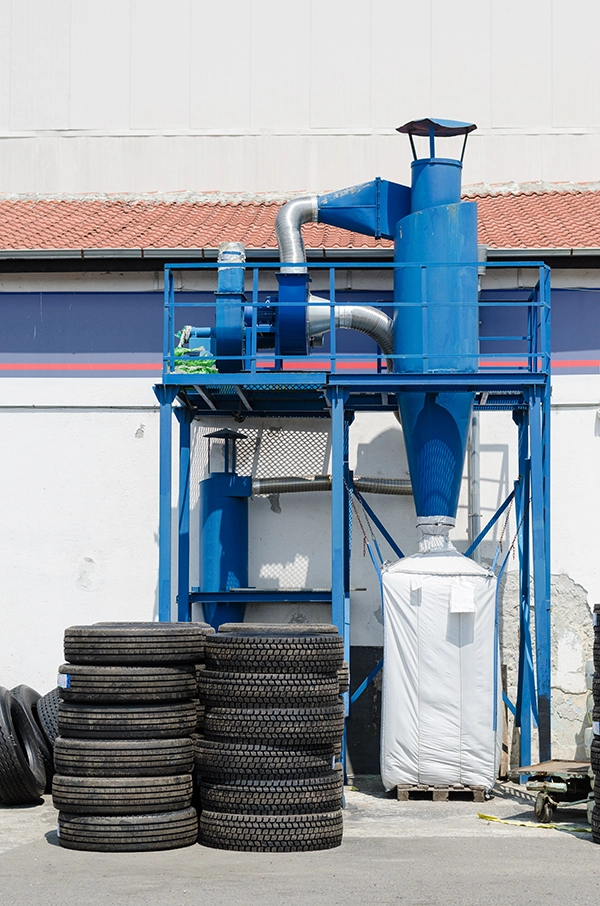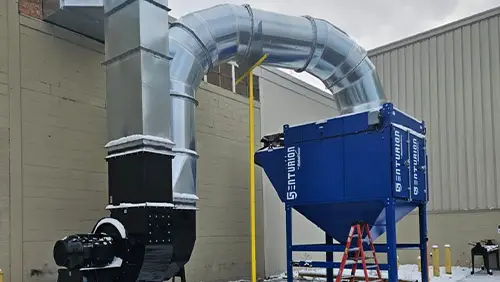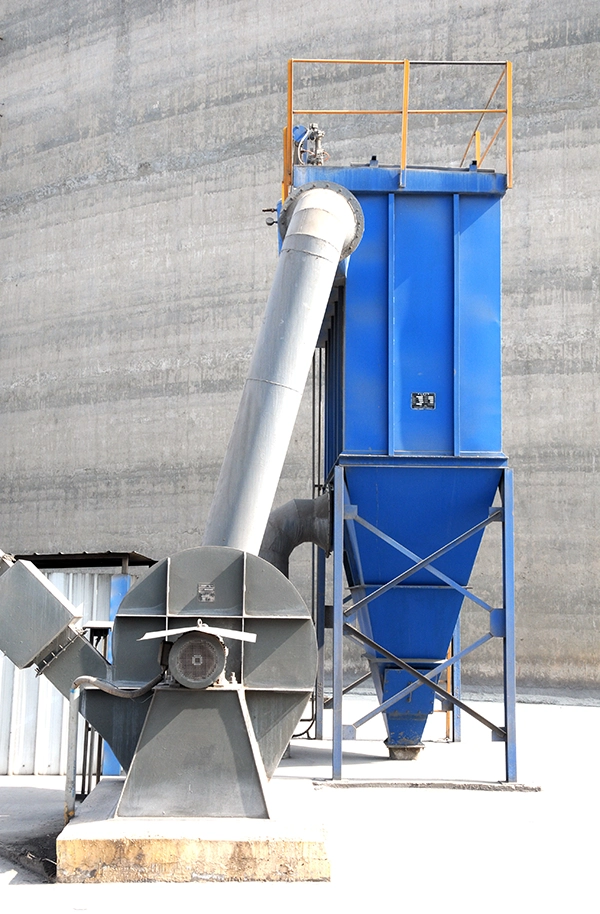Baghouse vs. Cartridge Dust Collectors: What’s the Difference?

When it comes to industrial dust collection, choosing the right system is critical for efficiency, performance, and compliance. Two of the most common options are baghouse dust collectors and cartridge dust collectors—but what’s the difference? Each system has distinct advantages depending on the application, dust type, and space constraints. In this article, we’ll break down the key differences between baghouse and cartridge dust collectors to help you determine the best solution for your facility.
What is a Cartridge Dust Collector
A cartridge dust collector is a type of industrial dust collection system designed to efficiently capture and filter fine dust particles from the air. Unlike baghouse dust collectors, which use fabric filter bags, cartridge dust collectors use pleated filter cartridges. These pleats provide a large surface area for filtration in a compact footprint, making cartridge systems a space-saving solution for many industrial environments.
Learn more: Guide to Cartridge Dust Collectors
Cartridge dust collectors use a system of fans to draw in contaminated air, directing it through pleated filter cartridges. The cartridges trap dust particles on their surface while allowing clean air to pass through. Over time, as dust builds up, a pulse-jet cleaning system (or similar mechanism) blasts compressed air into the filters, dislodging accumulated dust, which then falls into a collection bin. This self-cleaning process helps maintain airflow efficiency and extends filter life.

Dust collector cartridge filters are available in filtration efficiencies up to MERV16, making cartridge collectors the best choice when dealing with fine, toxic or hazardous particulates such as weld fumes or ultrafine powders. Some cartridge dust collectors, such as RoboVent Senturion, can also be equipped with HEPA or activated carbon after-filters for superior control of submicron particulate or gas-phase emissions, such as VOCs.

Cartridge dust collectors use cylindrical, pleated filters. The pleated filter media allows them to collect more dust in a smaller area, giving cartridge dust collectors a smaller footprint per CFM (airflow).
Download the Dust Collector Cartridge Filters Buying Guide to explore filter options for cartridge dust collectors.
Advantages of Cartridge Dust Collectors
Cartridge dust collectors offer significant benefits for industrial dust collection, particularly in applications where space, efficiency, and ease of maintenance are critical factors. Their pleated filter design provides a larger surface area in a smaller footprint, allowing them to capture fine particulates more effectively than baghouse systems. Because of their compact size, high efficiency, and quick-change filters, cartridge collectors are an excellent choice for facilities looking to optimize dust control with simpler maintenance and lower energy costs.
A cartridge collector is known for:
- High filtration efficiency: Cartridge collectors capture fine and hazardous dust particles effectively, making them ideal for applications requiring clean air and high air quality standards, as well as applications involving highly toxic or hazardous dust with strict permissible exposure limits (PELs).
- Compact design: Their smaller footprint per CFM allows them to fit in tight spaces, making them a great choice for facilities with limited room or growing dust collection needs.
- Versatility: Cartridge collectors come in a range of sizes and configurations, from small portable fume extractors to large centralized dust collection systems, which can be installed indoors or out. This versatility makes them appropriate for a wide range of industries and applications.
- Fast and easy filter replacement: Cartridges can be quickly swapped out without special tools and without crawling inside the machine, minimizing downtime and improving worker safety.
Applications for Cartridge Dust Collectors
Because of their compact design, high efficiency, and ease of maintenance, cartridge dust collectors are an excellent choice for industries requiring fine particulate filtration without the footprint and complexity of a baghouse system. Cartridge dust collectors are ideal for dust collection applications involving fine or submicron dust and requiring up to 1,000 cubic feet per minute (CFM) of airflow. With the right filter media and intake options, some cartridge collectors, such as RoboVent Senturion, are also suitable for high-CFM applications involving coarse, abrasive dust, or heavy dust loads for powder & bulk applications.
The versatility of a cartridge dust collector makes it well-suited for most industrial applications, including:
- General Fabrication & Welding: Captures welding fumes, grinding particulates, and metal dust, ensuring a cleaner and safer work environment.
- Food Processing: Effective for capturing fine dust from flour, sugar, spices, and other ingredients, helping to maintain cleanliness and comply with food safety standards.
- Pharmaceutical Manufacturing: Ensures the containment of hazardous drug powders and maintains air purity in cleanroom environments.
- Battery Manufacturing: Essential for controlling fine particulates from lithium-ion and lead-acid battery production, improving air quality and safety.
- Electronics & Semiconductor Manufacturing: Protects sensitive equipment from airborne dust and particulate contamination.
- General Manufacturing: Used in machining, sanding and finishing processes in automotive, aerospace and other manufacturing environments where fine metal and composite dust must be controlled.
- Plastics and FRPs: The pleated filter media used by cartridge dust collectors are ideal for collecting plastic fines and airborne particulates from plastic molding, trimming, sanding, and composite material processing.
- Job Shops & Welding Schools: Compact, easy-to-maintain systems make cartridge collectors the preferred choice for small-to-medium-sized fabrication shops and educational facilities.
What is a Baghouse Dust Collector?
A baghouse dust collector is a type of industrial dust collection system that uses fabric filter bags to capture airborne dust and particulates. These systems are typically used in large-scale industrial operations that generate high volumes of dust. Baghouse dust collectors rely on long, cylindrical filter bags that trap dust as air is drawn through them, allowing clean air to be released back into the workspace.
In a baghouse system, contaminated air is pulled into the collector, where it passes through a series of fabric filter bags. As the air moves through, dust particles accumulate on the surface of the bags while clean air exits through the system’s exhaust. To prevent clogging and maintain efficiency, baghouse dust collectors use cleaning mechanisms—such as pulse-jet cleaning or mechanical shaking—to periodically dislodge dust from the bags, which then falls into a collection bin for disposal.

Baghouse dust collectors come in several designs, each suited for different industrial applications and dust types. Here are the most common types:
- Shaker Baghouse: Uses mechanical shaking to clean filter bags; best for intermittent-use applications with lower dust volumes.
- Reverse Air Baghouse: Uses low-pressure reverse airflow to dislodge dust, offering gentle cleaning that extends filter life but requires more space.
- Pulse-Jet Baghouse: Uses short bursts of compressed air for continuous self-cleaning, making it ideal for high-dust-load environments.
- Envelope (Flat) Baghouse: Uses flat, envelope-shaped filter bags for a compact design, suited for applications with less abrasive dust.

Baghouse filters come in various styles for shaker, reserve air, pulse-jet and envelope-style dust collectors.
Looking for baghouse filters? We stock a wide selection of replacement baghouse filters for various makes and models. See our baghouse filter cross sheet.
Advantages of Baghouse Dust Collectors
Baghouse dust collectors have been a trusted solution for industrial dust collection for decades, particularly in environments with high dust volumes and challenging conditions. Their durable design, high airflow capabilities and ability to handle coarse, fibrous, and high-temperature dust make them a reliable choice for heavy-duty applications.
- Effective for high dust loads: Well-suited for applications that generate large volumes of coarse or fibrous dust, such as sawmills, cement production, and mining.
- Durable in harsh environments: Designed to withstand extreme temperatures, moisture, and abrasive dust, making them ideal for heavy industrial settings.
- Handles sticky or fibrous dust: Some baghouse systems, such as shakers, are well-suited for materials that tend to clump, such as grain dust or textile fibers.
- Scalable for large operations: Baghouses are most efficient for massive industrial plants and high-CFM applications.
Applications for Baghouse Dust Collectors
Baghouse systems are commonly used in heavy-duty industrial environments. While baghouse dust collectors are a reliable choice for high-dust environments, they require more space due to their larger size and often involve more maintenance when compared to cartridge dust collectors.
Baghouse dust collectors are at their best in applications requiring very high airflow and involving high dust loads, such as:
- Woodworking and sawmills: Captures sawdust and wood particulates.
- Cement and asphalt production: Handles dense, heavy dust from mixing and processing.
- Mining and bulk material handling: Manages high dust loads from crushing, grinding and material transfer.
- Agriculture and grain processing: Controls airborne dust from grain handling and feed production.
Key Differences Between Baghouse and Cartridge Dust Collectors
Both baghouse and cartridge dust collectors serve the same fundamental purpose—removing airborne dust and particulates from industrial environments. However, they differ significantly in design, efficiency, space requirements, and maintenance. Choosing the right system depends on factors such as dust type, facility size and operational needs. Here’s a breakdown of the key differences.
Filtration Media & Efficiency
- Baghouse dust collectors use fabric filter bags that work well for handling heavy, coarse and fibrous dust but may struggle with fine particulates. They are also effective for hygroscopic dust that forms a solid dust cake.
- Cartridge dust collectors use pleated filter cartridges, which provide a larger filtration surface in a smaller space, making them highly efficient at capturing fine and hazardous dust.
Airflow (CFM)
- Baghouse dust collectors are designed to handle high airflow volumes (CFM), making them ideal for large-scale operations with heavy dust loads and continuous processes.
- Cartridge dust collectors are optimized for moderate to high airflow in compact systems, efficiently managing fine dust without requiring the large footprint of a baghouse.
Size & Space Requirements
- Baghouse collectors are generally large and require ample space for installation, making them more suitable for big facilities with high dust volumes.
- Cartridge collectors have a compact design, making them ideal for applications where space is limited.
Maintenance & Filter Replacement
- Baghouse systems are harder to service, as filter changes can be labor-intensive and often involve crawling into the collector.
- Cartridge collectors have quick-change filters that are easy to replace from outside the collector, minimizing downtime and maintenance costs.
Energy Efficiency
- Some styles of baghouse collectors may have higher pressure drop, requiring more energy to maintain airflow.
- Cartridge collectors are designed for high efficiency and may have lower pressure drop, reducing energy consumption.
Best Applications
- Baghouse systems excel in environments with large dust volumes, heavy or abrasive dust, and high temperatures, such as cement, mining and woodworking. They are also preferred for applications with highly hygroscopic (water-absorbing) dust, such as cement dust, which form a heavy dust cake on the filter media. A baghouse filter can expand to “crack off” this accumulated cake.
- Cartridge systems are better suited for applications with fine, dry dust, such as welding, metalworking, and pharmaceutical processing. General manufacturing process nuisance dusts, food, plastics, FRP dust, metal dusts, fumes. With appropriate filtration and intake options, cartridge collectors can also be used for heavy bulk & powder applications. When dealing with sticky, oily or hygroscopic dust (e.g., sugar or other food dusts), specialized coatings or washable filter media may be required.
Comparison Table: Cartridge vs. Baghouse Dust Collectors
| Feature | Baghouse Dust Collector | Cartridge Dust Collector |
|---|---|---|
| Filtration Media | Fabric filter bags | Pleated filter cartridges |
| Filtration Efficiency | Good for heavy, coarse dust | Excellent for fine and hazardous dust |
| Size & Space | Large footprint, requires significant space | Compact design, space-saving |
| Airflow | More efficient for very high-airflow applications (>100,000 CFM) | Come in a range of sizes and CFM capacities with airflow up to 100,000 CFM |
| Maintenance | More labor-intensive, harder to change bags | Quick and easy filter replacement |
| Energy Efficiency | Higher energy usage due to pressure drop | Lower energy consumption per CFM |
| Best for Industries | Heavy, abrasive dust loads: cement, mining, sawmills | A wide range of applications: welding, metalwork, pharma, food, chemical, powder & bulk |
Cartridge vs. Baghouse: Choosing the Best Dust Collector
Both baghouse and cartridge dust collectors are effective at managing industrial dust, but the right choice depends on the specific needs of your facility. If you need to handle very large volumes of heavy dust and have ample space, a baghouse system may be the best fit. However, if you’re dealing with fine or hazardous particulates and want a compact, energy-efficient, and easy-to-maintain solution, a cartridge dust collector is often the smarter choice. Today’s cartridge dust collectors come in a range of sizes and are suitable for almost all industrial dust collection applications.
Choosing the right dust collection system is crucial for maintaining air quality, efficiency and compliance in your facility. RoboVent’s experts can help you assess your specific dust collection needs and support you with dust collection system design and engineering services to maximize performance while minimizing operational costs and energy use. Contact us today to speak with a dust collection specialist and find the best solution for your operation.
Contact Us With Your Questions!
SUBSCRIBE TO
BLOG UPDATES









